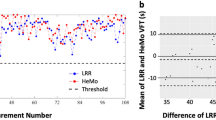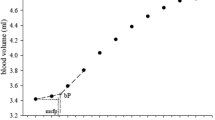Abstract
Background/aim:
Obesity is a risk factor for chronic venous disease. However, the mechanisms behind this association are poorly understood. We tested the hypothesis that obese subjects have a higher diurnal leg volume increase compared with non-obese subjects.
Methods:
In this prospective cohort study including obese (body mass index, BMI ⩾30 kg m−2) and non-obese (BMI ⩽25 kg m−2) subjects without venous insufficiency, lower leg volume was assessed by optoelectronic volumetry in the morning and in the evening. All subjects underwent duplex ultrasound and light reflection rheography (venous pump power and venous refill time, VRT) to investigate lower extremity venous function. A pedometer was carried between the morning and evening visit to assess the daily number of footsteps. A backward multivariable linear regression model was used to determine factors associated with diurnal lower leg volume increase.
Results:
Forty-two limbs in 24 obese subjects and 29 limbs in 15 non-obese subjects were analyzed. Obese subjects had larger common femoral vein diameters (17.1±2.4 vs 15.5±2.4 mm, P<0.01) and slower peak, mean and minimal velocities (25.1±10.6 vs 44.3±14.3 cm s−1; 6.8±2.4 vs 12.7±5.6 cm s−1; −0.2±6.4 vs −6.3±11.9 cm s−1; P<0.01 for all) than non-obese subjects. VRT was shorter in obese subjects (40.5±15.0 vs 51.0±12.1 s, P<0.01) and decreased significantly in the course of the day only in obese subjects (P<0.01). Obesity, male gender, CEAP (Clinical-Etiology-Anatomy-Pathophysiology) class, total time between the two visits and difference between morning and evening VRT were positively associated with higher lower leg volume increase; morning VRT and the total number of footsteps showed a negative association (P<0.04 for all).
Conclusion:
Obesity was found to be an independent predictor of higher diurnal leg volume increase. One potential mechanism is a progressive failure of venous valve function in the course of the day in obese subjects.
This is a preview of subscription content, access via your institution
Access options
Subscribe to this journal
Receive 12 print issues and online access
$259.00 per year
only $21.58 per issue
Buy this article
- Purchase on Springer Link
- Instant access to full article PDF
Prices may be subject to local taxes which are calculated during checkout
Similar content being viewed by others
References
Evans CJ, Fowkes FG, Ruckley CV, Lee AJ . Prevalence of varicose veins and chronic venous insufficiency in men and women in the general population: Edinburgh vein study. J Epidemiol Community Health 1999; 53: 149–153.
Ageno W, Piantanida E, Dentali F, Steidl L, Mera V, Squizzato A et al. Body mass index is associated with the development of the post-thrombotic syndrome. Thromb Haemost 2003; 89: 305–309.
Danielsson G, Eklof B, Grandinetti A, Kistner RL . The influence of obesity on chronic venous disease. Vasc Endovascular Surg 2002; 36: 271–276.
Ashrani AA, Silverstein MD, Lahr BD, Petterson TM, Bailey KR, Melton LJ 3rd et al. Risk factors and underlying mechanisms for venous stasis syndrome: A population-based case-control study. Vasc Med 2009; 14: 339–349.
Williams A . Chronic oedema in patients with cvi and ulceration of the lower limb. Br J Community Nurs 2009; 14: 6–8.
Partsch H . Varicose veins and chronic venous insufficiency. Vasa 2009; 38: 293–301.
Requena C, Sanmartin O, Requena L . Sclerosing panniculitis. Dermatol Clin. 2008; 26: 501–504 vii.
Blattler W, Kreis N, Lun B, Winiger J, Amsler F . Leg symptoms of healthy people and their treatment with compression hosiery. Phlebology 2008; 23: 214–221.
Engelberger RP, Blazek C, Amsler F, Keo HH, Baumann F, Blattler W et al. Reproducibility and day time bias correction of optoelectronic leg volumetry: A prospective cohort study. BMC Med Res Methodol 2011; 11: 138.
World Health Organization. Obesity: preventing and managing the global epidemic. Report of a WHO consultation. World Health Organ Tech Rep Sers 2000; 894, i-xii 1–253.
Eklof B, Rutherford RB, Bergan JJ, Carpentier PH, Gloviczki P, Kistner RL et al. Revision of the ceap classification for chronic venous disorders: Consensus statement. J Vasc Surg 2004; 40: 1248–1252.
Gloviczki P, Comerota AJ, Dalsing MC, Eklof BG, Gillespie DL, Gloviczki ML et al. The care of patients with varicose veins and associated chronic venous diseases: Clinical practice guidelines of the society for vascular surgery and the american venous forum. J Vasc Surg 2011; 53: 2S–48S.
World Medical Association General Assembly. World Medical Association Declaration of Helsinki: Ethical principles for medical research involving human subjects. J Int Bioethique 2004; 15: 124–129.
Kahle B, Hennies F, Bolz S, Pritsch M . The reproducibility of the ratio of volume flow in the common femoral vein and artery for quantification of the severity of venous insufficiency. Vasa 2003; 32: 199–203.
Lurie F, Ogawa T, Kistner RL, Eklof B . Changes in venous lumen size and shape do not affect the accuracy of volume flow measurements in healthy volunteers and patients with primary chronic venous insufficiency. J Vasc Surg 2002; 35: 522–526.
Engelberger RP, Keo HH, Blaettler W, Fahrni J, Baumann F, Diehm N et al. The impact of orthostatic challenge on arterio-venous hemodynamics and volume changes of the lower extremity. J Vasc Surg: Venous Lym Dis 2013; 1: 250–256.
Delis KT, Nicolaides AN, Stansby G . Effect of posture on popliteal artery hemodynamics. Arch Surg 2000; 135: 265–269.
Jeanneret C, Jager KA, Zaugg CE, Hoffmann U . Venous reflux and venous distensibility in varicose and healthy veins. Eur J Vasc Endovasc Surg 2007; 34: 236–242.
Yamaki T, Nozaki M, Sakurai H, Takeuchi M, Soejima K, Kono T . Comparison of manual compression release with distal pneumatic cuff maneuver in the ultrasonic evaluation of superficial venous insufficiency. Eur J Vasc Endovasc Surg 2006; 32: 462–467.
Hach W, Langer C, Schirmers U . [arthrogenic congestive syndrome]. Vasa 1983; 12: 109–116.
Nicolaides AN . Investigation of chronic venous insufficiency: A consensus statement (france, march 5-9, 1997). Circulation 2000; 102: E126–E163.
Crouter SE, Schneider PL, Karabulut M, Bassett DR Jr . Validity of 10 electronic pedometers for measuring steps, distance, and energy cost. Med Sci Sports Exerc 2003; 35: 1455–1460.
Glidden DV, Vittinghoff E . Modelling clustered survival data from multicentre clinical trials. Stat Med 2004; 23: 369–388.
Kugler C, Strunk M, Rudofsky G . Venous pressure dynamics of the healthy human leg. Role of muscle activity, joint mobility and anthropometric factors. J Vasc Res 2001; 38: 20–29.
Arfvidsson B, Eklof B, Balfour J . Iliofemoral venous pressure correlates with intraabdominal pressure in morbidly obese patients. Vasc Endovascular Surg 2005; 39: 505–509.
Willenberg T, Schumacher A, Amann-Vesti B, Jacomella V, Thalhammer C, Diehm N et al. Impact of obesity on venous hemodynamics of the lower limbs. J Vasc Surg 2010; 52: 664–668.
Willenberg T, Clemens R, Haegeli LM, Amann-Vesti B, Baumgartner I, Husmann M . The influence of abdominal pressure on lower extremity venous pressure and hemodynamics: A human in-vivo model simulating the effect of abdominal obesity. Eur J Vasc Endovasc Surg 2011; 41: 849–855.
Jeanneret C, Labs KH, Aschwanden M, Bollinger A, Hoffmann U, Jäger K . Physiological reflux and venous diameter change in the proximal lower limb veins during a standardised Valsalva manoeuvre. Eur J Vasc Endovasc Surg 1999; 17: 398–403.
Meissner MH, Moneta G, Burnand K, Gloviczki P, Lohr JM, Lurie F et al. The hemodynamics and diagnosis of venous disease. J Vasc Surg 2007; 46 (Suppl S): 4S–24S.
Shepherd AC, Gohel MS, Lim CS, Davies AH . A study to compare disease-specific quality of life with clinical anatomical and hemodynamic assessments in patients with varicose veins. J Vasc Surg 2010; 53: 374–382.
Katz ML, Comerota AJ, Kerr RP, Caputo GC . Variability of venous-hemodynamics with daily activity. J Vasc Surg 1994; 19: 361–365.
Krijnen RM, de Boer EM, Ader HJ, Bruynzeel DP . Venous insufficiency in male workers with a standing profession. Part 2: Diurnal volume changes of the lower legs. Dermatology 1997; 194: 121–126.
Clemes SA, Hamilton SL, Lindley MR . Four-week pedometer-determined activity patterns in normal-weight, overweight and obese adults. Preventive Med 2008; 46: 325–330.
Acknowledgements
We thank the Swiss Society of Phlebology who supported this project financially with the SSP Award 2011. The funding source did not have any influence in the analysis and interpretation of data, in the writing of the manuscript or in the decision to submit the paper for publication. The authors retain the sole responsibility for the content of the paper.
Author information
Authors and Affiliations
Corresponding author
Ethics declarations
Competing interests
The authors declare no conflict of interest.
Rights and permissions
About this article
Cite this article
Engelberger, R., Indermühle, A., Baumann, F. et al. Diurnal changes of lower leg volume in obese and non-obese subjects. Int J Obes 38, 801–805 (2014). https://doi.org/10.1038/ijo.2013.178
Received:
Revised:
Accepted:
Published:
Issue Date:
DOI: https://doi.org/10.1038/ijo.2013.178



